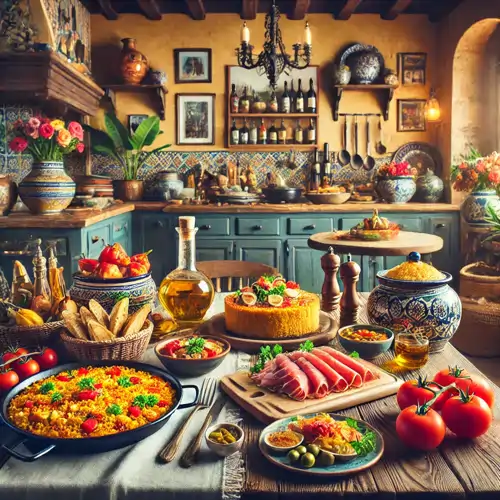Spanish Cuisine: Key Features
Many people planning a trip to Spain or simply interested in Spanish culture have several questions. How to navigate the multitude of local dishes? How to avoid ordering something you might not like? Where to find the best balance between price and quality? In this article, we’ll explore why Spanish cuisine is so diverse and which national dishes deserve special attention.
The main “concerns” of visitors to the country are the fear of ordering an unfamiliar dish, confusion with names, and uncertainty about the ingredients. The solution lies in understanding the components and preparation traditions. Below, we’ll explain what ingredients are most commonly used in Spanish cuisine, which dishes are the most popular, and what makes them unique.
What Defines Spanish Cuisine
Spain has many regions, each contributing its own flavor to the country’s culinary palette. However, there are common features.
- Spaniards make extensive use of meat, especially pork.
- Seafood is popular due to the long coastline: shrimp, squid, mussels.
- Rice and olive oil are staples, essential for many recipes.
- Fruits and vegetables, including tomatoes, peppers, oranges, and grapes, are integral to local cooking.
- Spanish cheeses are widely known: Manchego, Cabrales, Ibores, and others.
Spices and Sauces
Almost all dishes include saffron, garlic, pepper, and herbs. Olive oil plays a significant role. Many traditional sauces, especially those for fish or seafood, are made with ground nuts (almonds) or tomatoes.
The Most Famous Meat Dishes
Meat is one of the main components of Spanish cuisine. Most restaurant menus feature several signature meat dishes.
- Jamón. Spain’s most famous product: dry-cured pork ham. It comes in Serrano and Ibérico varieties, the latter from pigs fed on acorns.
- Chorizo. A cured pork sausage seasoned with paprika and garlic. Often found in hot dishes and appetizers.
- Roast Chicken. Chickens stuffed with vegetables and roasted, sometimes with cider or sherry (Jerez — fortified wine).
Popular First Courses
Soups are an important part of the Spanish table: cold soups are cherished in the warm climate, while hearty stews are common in northern regions.
- Gazpacho. A cold tomato soup with olive oil, cucumber, onion, and pepper, sometimes with a touch of vinegar. Perfect for summer heat.
- Cocido Madrileño. A traditional Madrid stew made with chickpeas, various meats, and sausages. It is slow-cooked for several hours.
- Fabada. A hearty Asturian stew made with white beans, pork, chorizo, and black pudding.
Spanish Main Dishes
- Paella. Numerous variations exist, but the classic version includes rice, seafood (squid, shrimp, mussels), and spices. There’s also meat paella (chicken, rabbit) or a mix.
- Spanish Tortilla. A potato omelet with onion and egg. It can also include chorizo, peppers, and other ingredients.
- Madrid Stew. Made with chickpeas, various meats (beef, chicken, pork), cabbage, and spices. It’s slow-cooked for several hours.
Appetizers and Quick Bites
In Spain, a variety of appetizers known as “tapas” are extremely popular. They are usually served with wine or beer.
- Tapas. A general term for both cold and hot small dishes: from olives and nuts to canapés with fish and meat rolls.
- Nachos. Corn chips often served with guacamole or melted cheese.
- Tomato Bread (sometimes called “pan con tomate”). A slice of bread rubbed with tomato, garlic, drizzled with olive oil, and sprinkled with a bit of salt.
Cheeses, Pastries, and Desserts
Spain offers a vast selection of cheeses, from soft goat cheeses to aged sheep cheeses. The desserts are equally impressive.
- Manchego. A sheep’s cheese from the La Mancha region, known for its firm, rich flavor.
- Churros. Fried dough sticks, usually served with hot chocolate or coffee.
- Turrón. A traditional sweet made from honey, egg whites, and nuts. Common during Christmas, but available year-round.
Beverages: From Wine to Clara
Spain produces wines of high quality with the DOC (Denominación de Origen Calificada) designation. The most famous are red wines from Rioja. Wine- and beer-based cocktails are also popular.
- Sangría. A low-alcohol beverage made from red wine and fruits, often with soda water or brandy.
- Clara. A mix of light beer and lemonade, a popular refreshing cocktail.
Practical Tips for Spanish Cuisine Enthusiasts
- Don’t hesitate to ask about the ingredients and preparation methods of dishes to avoid unwanted surprises.
- If in doubt, start with simple and familiar options: tortilla, gazpacho, jamón. These are safe bets.
- Experiment with tapas to try several dishes at once and discover your favorites.
- Pay attention to regional variations: the same recipe is often prepared differently in different areas.
Conclusion: Food as Part of Culture
Spanish national dishes are not just about culinary diversity but also cultural heritage. Understanding what and how locals eat provides deeper insights into the traditions and history of the country. If you appreciate good taste and want to discover something new, exploring Spanish cuisine will be a rewarding experience.








